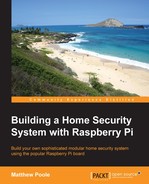Before we can go on to connect off-the-shelf security devices to our alarm system, we need to have a power supply that's compatible with such devices. Typically, alarm circuits and their devices use a 12V supply with enough current to drive all the devices and the alarm control system itself.
Fortunately, this is not too difficult to sort out, but it is something we need to do now; otherwise, we won't be able to connect and power our PIR sensors. The easiest way to do this is to buy a high-quality 12V mains adapter that provides a nice regulated supply. These are readily available from online stores or electronics suppliers. Alternatively, you can build your own 12V regulated supply and add it to the power supply strip board that we built in Chapter 3, Extending Your Pi to Connect More Things.
Note
Another option is to use battery-powered PIR sensors, which means that you wouldn't have to power the unit from the security system's panel itself; however, it obviously also means that the batteries would need replacing from time to time. The wireless PIR we will look at later in this chapter is battery-powered.
We'll take a look at handling higher-voltage sensor circuits later on in this chapter so that we don't blow up our home security control circuits or the Raspberry Pi.
